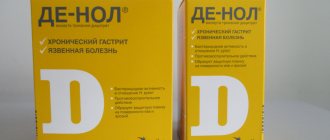Release form, packaging and composition of the drug Clinical-pharmacological group Pharmaco-therapeutic group Pharmacological action Indications for use Method of administration and doses Side effects Contraindications for use Use in children Special instructions Drug interactions
Registration Certificate Holder:
GLAXO WELLCOME, GmbH & Co (Germany)
ATX Code:
N02BE01
Active substance:
paracetamol
Dosage form:
Calpol
| The drug is approved for use as an over-the-counter product | Calpol | Susp. for oral administration for children 120 mg/5 ml: vial. 70 ml or 100 ml reg. No.: P N015380/01 dated 03/20/09 - Cancellation of State. registration |
Pharmacokinetics
Cmax in plasma is achieved 30–90 minutes after oral administration. The ratio of volume of distribution to bioavailability in children and neonates is similar to that in adults. T1/2 - 1.5–2.5 hours. Metabolized in the liver. In newborns and children under 10 years of age, the main metabolite is paracetamol sulfate, in children 12 years of age and older - conjugated glucuronide. With a lack of glutathione, these metabolites can block the enzyme systems of hepatocytes and cause their necrosis. Approximately 85–95% of the dose is excreted in the urine within 24 hours (less than 4% of the drug is unchanged).
Release form, packaging and composition of the drug Calpol
Oral suspension for children
pink color with strawberry scent.
| 5 ml | |
| paracetamol | 120 mg |
Excipients
: sugar syrup, sorbitol 70%, glycerol, gum, methyl parahydroxybenzoate, carmoisin (E122), flavoring, purified water.
70 ml - dark glass bottles (1) complete with a 2.5 and 5 ml measuring spoon - cardboard boxes. 100 ml - dark glass bottles (1) complete with a 2.5 and 5 ml measuring spoon - cardboard boxes.
Directions for use and doses
Orally, with plenty of liquid, 1–2 hours after meals, 3–4 times a day with an interval of at least 4 hours.
Calpol suspension for children should not be diluted. For convenience and accuracy of dosing, use a measuring spoon that measures 2.5 and 5 ml of suspension.
Recommended doses for children from 3 months to 6 years
| Age | Single doses |
| 3 months - 1 year | 60–120 mg paracetamol (2.5–5 ml) |
| From 1 year to 6 years | 120–240 mg paracetamol (5–10 ml) |
Duration of treatment: 3 days as an antipyretic and up to 5 days as an analgesic. If it is necessary to continue taking the drug, consult a doctor.
Calpol (susp. for oral administration for children 120 mg/5 ml 100 ml)
Active substance
Paracetamol + Ascorbic acid
Compound
Bottle 100 ml Paracetamol 120 mg per 5 ml. Excipients: sugar syrup, sorbitol 70%, glycerol, gum, methyl parahydroxybenzoate, carmoisin (E122), flavoring, purified water. Oral suspension for children, pink in color with strawberry scent.
pharmachologic effect
Analgesic-antipyretic. It has analgesic and antipyretic properties. The mechanism of action is associated with inhibition of prostaglandin synthesis. Paracetamol does not affect water-electrolyte metabolism (does not lead to sodium and water retention) and does not have a damaging effect on the gastrointestinal mucosa.
Indications for use
The drug is prescribed to children aged 3 months to 6 years as: - an antipyretic for acute respiratory diseases, influenza, childhood infections, post-vaccination reactions and other conditions accompanied by an increase in temperature; - an analgesic for pain of mild to moderate intensity, incl. headache and toothache, muscle pain, neuralgia, pain from injuries and burns. The question of the possibility of using the drug Calpol for these indications in children aged 1 to 3 months is decided individually by the attending physician.
Side effects
Possible: nausea, vomiting, abdominal pain, allergic reactions in the form of skin rash, itching, urticaria, Quincke's edema. Rarely: anemia, leukopenia, agranulocytosis, thrombocytopenia. With long-term use in high doses, hepatotoxic and nephrotoxic effects are possible, as well as the occurrence of pancytopenia and methemoglobinemia. When taken in recommended doses, paracetamol rarely causes serious side effects.
Contraindications
- severe liver dysfunction;
- severe renal dysfunction; - blood diseases; - deficiency of glucose-6-phosphate dehydrogenase; - children up to 1 month; - hypersensitivity to the components of the drug. The drug is prescribed with caution for mild to moderate impairment of liver or kidney function, Gilbert, Dubin-Johnson and Rotor syndrome. Use in children The drug is contraindicated in children under 1 month of age. Age Single doses 3 months-1 year 60-120 mg of paracetamol (2.5-5 ml of suspension) from 1 year to 6 years 120-240 mg of paracetamol (5-10 ml of suspension)
Mode of application
Calpol suspension is taken orally 1-2 hours after meals with plenty of liquid. The frequency of administration is 3-4 times a day with an interval of at least 4 hours. The suspension should not be diluted; for convenience and accuracy of dosing, it is recommended to use the included measuring spoon (marked for 2.5 and 5 ml). Recommended doses for children from 3 months to 6 years are presented in the table. Age | Single doses 3 months-1 year | 60-120 mg paracetamol (2.5-5 ml suspension) from 1 year to 6 years | 120-240 mg paracetamol (5-10 ml suspension) Duration of therapy is 3 days when used as an antipyretic; up to 5 days - as an analgesic.
special instructions
You should avoid using Calpol simultaneously with other paracetamol-containing drugs, because this may lead to an overdose of paracetamol. When using the drug for more than 5-7 days, the peripheral blood picture and indicators of the functional state of the liver should be monitored. The suspension contains sugar, which should be taken into account when treating patients with diabetes. Paracetamol distorts the results of laboratory tests to determine the content of glucose and uric acid in blood plasma. You should be warned about the need to consult a doctor if a high temperature persists for more than 3 days and pain persists for more than 5 days.
Overdose
Symptoms: the most common and early symptoms include pale skin, increased sweating, stomach pain, nausea, and vomiting. After 1-2 days, signs of liver damage may appear - pain in the liver area, increased activity of liver enzymes, increased prothrombin time. In severe cases, liver failure, hepatonecrosis, encephalopathy, and coma develop. Treatment: gastric lavage, taking enterosorbents (activated carbon, polyphepan), intravenous administration of the antidote N-acetylcysteine or taking methionine orally. The patient should be informed that if overdose symptoms occur, stop taking the drug and consult a doctor.
Interaction with other drugs
When used together with barbiturates, tricyclic antidepressants, ethanol, anticonvulsants (phenytoin), phenylbutazone, rifampicin, the risk of developing the hepatotoxic effect of paracetamol significantly increases. When taken together with salicylates, the nephrotoxic effect of paracetamol increases. Combined use with chloramphenicol leads to an increase in the toxic properties of the latter. Paracetamol enhances the effect of indirect anticoagulants and weakens the effect of uricosuric drugs.
Overdose
Symptoms: pallor, sweating, stomach pain, nausea and vomiting, after 1–2 days - signs of liver damage (pain in the liver, increased activity of liver enzymes in the blood, increased prothrombin time). In severe cases - liver failure, hepatonecrosis, encephalopathy, coma.
Treatment: discontinuation of the drug, gastric lavage, administration of enterosorbents (activated carbon, polyphepan), intravenous administration of the antidote - N-acetylcysteine or oral administration of methionine.
Calpol
From the skin: itching, rash on the skin and mucous membranes (usually erythematous, urticaria), angioedema, exudative erythema multiforme (including Stevens-Johnson syndrome), toxic epidermal necrolysis (Lyell's syndrome).
From the side of the central nervous system (usually develops when taking high doses): dizziness, psychomotor agitation and disorientation.
From the digestive system: nausea, epigastric pain, increased activity of liver enzymes, usually without the development of jaundice, hepatonecrosis (dose-dependent effect).
From the endocrine system: hypoglycemia, up to hypoglycemic coma.
From the hematopoietic organs: anemia, sulfhemoglobinemia and methemoglobinemia (cyanosis, shortness of breath, heart pain), hemolytic anemia (especially for patients with glucose-6-phosphate dehydrogenase deficiency). With long-term use in large doses - aplastic anemia, pancytopenia, agranulocytosis, neutropenia, leukopenia, thrombocytopenia.
From the urinary system: (when taking large doses) - nephrotoxicity (renal colic, interstitial nephritis, papillary necrosis). Overdose. Symptoms (acute overdose develops 6-14 hours after taking the drug, chronic - 2-4 days after exceeding the dose) of acute overdose: dysfunction of the gastrointestinal tract (diarrhea, loss of appetite, nausea and vomiting, abdominal discomfort and/or pain in stomach), increased sweating.
Symptoms of chronic overdose: a hepatotoxic effect develops, characterized by general symptoms (pain, weakness, adynamia, increased sweating) and specific ones characterizing liver damage. As a result, hepatonecrosis may develop. The hepatotoxic effect of the drug may be complicated by the development of hepatic encephalopathy (thought disturbances, central nervous system depression, stupor), convulsions, respiratory depression, coma, cerebral edema, hypocoagulation, development of disseminated intravascular coagulation syndrome, hypoglycemia, metabolic acidosis, arrhythmia, collapse. Rarely, liver dysfunction develops suddenly and can be complicated by renal failure (renal tubular necrosis).
Treatment: administration of SH-group donors and precursors for the synthesis of glutathione - methionine 8-9 hours after an overdose and N-acetylcysteine - after 12 hours. The need for additional therapeutic measures (further administration of methionine, intravenous administration of N-acetylcysteine) is determined in depending on the concentration of the drug in the blood, as well as on the time elapsed after its administration.
Similar drugs:
- Katadolon Capsule
- Ibuprom Max Oral tablets
- Solpadeine Effervescent tablets
- Milgamma compositum Dragee
- Mesipol Solution for intramuscular administration
- Xefocam (Xefocam) Lyophilisate for the preparation of solution for injection
- Melbek Solution for injection
- Efferalgan Rectal suppositories
- Mesulide Oral tablets
- Amidopyrinum Oral tablets
** The Drug Directory is intended for informational purposes only. For more complete information, please refer to the manufacturer's instructions. Do not self-medicate; Before starting to use the drug Calpol, you should consult a doctor. EUROLAB is not responsible for the consequences caused by the use of information posted on the portal. Any information on the site does not replace medical advice and cannot serve as a guarantee of the positive effect of the drug.
Are you interested in the drug Calpol? Do you want to know more detailed information or do you need a doctor's examination? Or do you need an inspection? You can make an appointment with a doctor - the Euro lab is always at your service! The best doctors will examine you, advise you, provide the necessary assistance and make a diagnosis. You can also call a doctor at home . Euro lab clinic is open for you around the clock.
** Attention! The information presented in this medication guide is intended for medical professionals and should not be used as a basis for self-medication. The description of the drug Calpol is provided for informational purposes and is not intended for prescribing treatment without the participation of a doctor. Patients need to consult a specialist!
If you are interested in any other drugs and medications, their descriptions and instructions for use, information about the composition and form of release, indications for use and side effects, methods of use, prices and reviews of drugs, or you have any other questions and suggestions - write to us, we will definitely try to help you.
Drug interactions
When used together with barbiturates, tricyclic antidepressants, ethanol, anticonvulsants (phenytoin), phenylbutazone, rifampicin, the risk of developing the hepatotoxic effect of paracetamol significantly increases. When taken together with salicylates, the nephrotoxic effect of paracetamol increases. Combined use with chloramphenicol leads to an increase in the toxic properties of the latter. Paracetamol enhances the effect of indirect anticoagulants and weakens the effect of uricosuric drugs.
Indications for use
The drug is prescribed to children aged 3 months to 6 years as:
- antipyretic for acute respiratory diseases, influenza, childhood infections, post-vaccination reactions and other conditions accompanied by fever;
- analgesic for pain of mild to moderate intensity, incl. headache and toothache, muscle pain, neuralgia, pain from injuries and burns.
The question of the possibility of using the drug Calpol for these indications in children aged 1 to 3 months is decided individually by the attending physician.
special instructions
You should avoid using Calpol simultaneously with other paracetamol-containing drugs, because this can lead to an overdose of paracetamol. When using the drug for more than 5-7 days, the peripheral blood picture and indicators of the functional state of the liver should be monitored. The suspension contains sugar, which should be taken into account when treating patients with diabetes. Paracetamol distorts the results of laboratory tests for determining glucose and uric acid in the blood plasma. You should be warned about the need to consult a doctor if a high temperature persists for more than 3 days and pain persists for more than 5 days.



